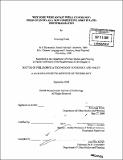Why some were so fast while others not : speed of entry as a new competitive asset in late-industrialization
Author(s)
Kwak, Jooyoung
DownloadFull printable version (13.14Mb)
Alternative title
Speed of entry as a new competitive asset in late-industrialization
Other Contributors
Massachusetts Institute of Technology. Dept. of Urban Studies and Planning.
Advisor
Alice H. Amsden.
Terms of use
Metadata
Show full item recordAbstract
The object of this dissertation is to gain an understanding of the speed of entry into high-tech industries by "latecomers," private and national firms from late-industrializing countries. While entry is traditionally measured with R&D performance, we have approached it from the perspective of skill formation. Accordingly, we have investigated how some latecomers have quickly learned new skills and connected their existing technical knowledge with a new stock of knowledge, defining the speedy (latecomer) entrant as the first latecomer (for an initial entry) and the first-to-market (for subsequent entries), respectively. Specifically, we have conceptualized that a fast entry requires a continuous search for new markets and adaptation to a new environment. In this regard, the speed of entry into the high-tech industries, based on the experience in the mid-tech industries, indicates of dynamic capability and, accordingly, becomes a competitive asset in the context of late-industrializing countries. Theories in economics, management, or geography, which our hypotheses for speed of entry are drawn from, have explained factors or mechanism that enable a firm to perform better. We have first examined how literature envisages the effects of business groups, a form of firms prevalent particularly in late-industrializing countries, in association with speed of entry. However, relevant theories tend to compete and the overall theoretical predictions are not clear. Second, we have further reviewed literature in technology management and expected integration to occur both externally and internally when entry is executed. Third, given that the relevant theories highlight geographic proximity for generating externalities, we have suggested different measurements of geographic proximity for international learning, a distance from the headquarters of the partner firm and an international joint venture. (cont.) Based on the literature review, we have postulated that business groups, integration capability, and geographic proximity are significantly associated with the speed of entry by latecomers and have constructed three hypotheses: H1. Speed of entry by latecomers is related to business groups; H2. Speed of entry by latecomers is related to integration capability; and H3. Speed of entry by latecomers is moderated by the relationship between their integration capability and geographic proximity. In order to test these hypotheses, we have adopted two methodologies, which are case study and regression analysis. Next, we have selected the thin film transistor liquid crystal diode (TFT-LCD) and wireless handsets industries. The TFT-LCD and wireless handset industries tend to have complementary features: TFT-LCD has a relatively short history compared to other electronics industries and is capital-intensive. In contrast, the wireless handsets are consumer goods and connected with the telecommunication service industry. Reviewing the histories of both industries, we have identified latecomer entrants and have subsequently collected their data by accessing available archives and interviewing managers and engineers. From the case studies, we have found in the fast latecomers several interesting points regarding entry dynamics: first, the owners of these latecomers continuously tried to upgrade their industrial technologies into more sophisticated ones by closely benchmarking the Japanese firms. Second, the fast latecomers mobilized managerial know-how from their firms and properly redeployed it to the necessary posts. Third, while managerial knowledge was possible to acquire within a firm, technical knowledge had to be externally supplied; but acquisition of the updated technical knowledge was extremely difficult. Fourth, due to the difficulties, latecomers accessed whatever sources they could and used whatever channels were available. (cont.) Therefore, no single path to acquiring the necessary knowledge was dominant. Unique aspects in skill formation and knowledge acquisition by latecomers have also been observed: while acquiring technical knowledge from outside sources, both the first latecomer and the first-to-market successfully relocated their skills from prior industries to the new ones quickly, for example, from semiconductor manufacturing to TFT-LCD or from beeper/car phone/cordless phone manufacturing to wireless handsets. Finally, in the TFT-LCD industry, the first latecomer and the first-to-market took advantage of business cycles and aggressively increased capital investment during downturns. In the wireless handset industry, these latecomers, associated with the government research institute, developed an alternative communication technology and quickly mass-produced it. However, not all counter-cycle investment strategies by latecomers in the TFT-LCD industry succeeded. Similarly, not all governmental efforts to incubate technologies were successful. Based on findings from case studies, we have also empirically tested our hypotheses. A brief summary of our regression analysis is that our first hypothesis is partially supported. The factors related to business groups are not necessarily significantly related to becoming the first latecomer or to making subsequent entries (the first-to-market performance) fast. In contrast, our second hypothesis is supported. The result indicates that the first latecomer performance and the first-to-market performance require different types of integration capability. Specifically, becoming the first latecomer is determined by efficiency in external learning, while the speed of subsequent product entries is driven primarily by internal efficiency. (cont.) We interpret that the relative weight of external learning may decrease over time, once a latecomer has entered. Finally, our third hypothesis is partially supported. Geographic proximity to the headquarters of the partner firm increases speed of entry, perhaps by facilitating communication and diffusing best practices, but international joint venture between a latecomer and a leading incumbent firm does not necessarily enhance integration with sources and does not expedite speed of entry.
Description
Thesis (Ph. D. in Technology Economics and Policy)--Massachusetts Institute of Technology, Dept. of Urban Studies and Planning, 2008. Includes bibliographical references (p. 125-144).
Date issued
2008Department
Massachusetts Institute of Technology. Department of Urban Studies and PlanningPublisher
Massachusetts Institute of Technology
Keywords
Urban Studies and Planning.